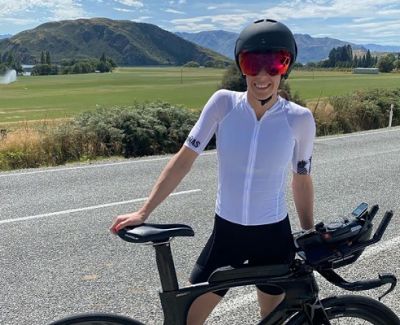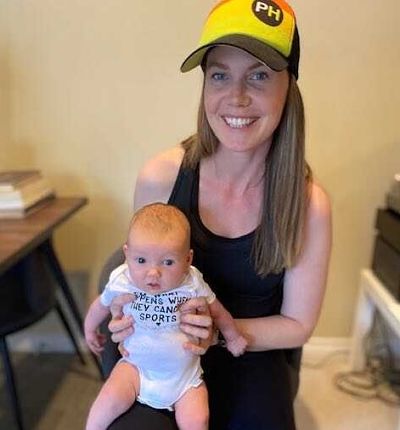Move over IRONMAN events and ultramarathons, a study exploring the limits of human endurance found that one of the most extreme experiences a person can endure is pregnancy.
Michelle Heneghan knows all about the challenges of both endurance sport and pregnancy after she turned pro as a triathlete in 2020 before welcoming baby Fiadh into the world in February 2021.
Fellow pro triathlete Mary Robbins is continuing to train during the second trimester of her pregnancy, so we caught up with the two Precision Fuel & Hydration Ambassadors to find out how they managed their training load and the demands of pregnancy...
Firstly, congratulations Michelle and Mary! Thanks for taking time out to join us. How did your pregnancy affect your ability to train? I imagine there was a significant change in your training volume pre- and during pregnancy?
Michelle: Well, I only turned pro as a triathlete in 2020 and I was still working part-time as a physiotherapist, usually working 3 or 4 days a week in a hospital here in Vancouver, so my volume was significantly less than other professional triathletes before my pregnancy.
Michelle's Average Training Week Pre-Pregnancy
| Activity | Duration (per week) |
|---|---|
| Swimming | 6 - 7 hours |
| Cycling | 6 - 8 hours |
| Running | 5 - 6 hours |
| Strength | 1 - 2 hours |
Pre-pregnancy training was certainly very different to my training during pregnancy which didn’t quite go as planned.
I had visions of being this very fit, pregnant athlete who could train right up until the later stages of pregnancy. However, I got hit with severe sickness after about 6 weeks and that lasted right up until I gave birth. I got medication that eventually started to work and kept the vomiting at bay towards the end, but the nausea was constant.
As a result, my pregnancy training ended up being more about staying active and healthy rather than structure.
Michelle's Average Training Week During Pregnancy
| Activity | Duration (per week) |
|---|---|
| Swimming | 3 x swims of 30-40mins (Up until 38 weeks of pregnancy) |
| Cycling | 1-2 mostly easy rides / gravel rides (Up until 24 weeks of pregnancy) |
| Running | 2-3 easy runs (Up until 24 weeks - had to stop due to pelvic and ligament pain) |
| Strength and Yoga | 2 sessions per week |
| Hiking | 1-2 longer hikes each week (+ lots of walking each day) |
*All of the above training depended on how sick I was each week.
Mary: Pre-2020, my training schedule averaged 15-20 hours a week. I have a swimming background, so I can get away with a little less volume in the pool, averaging about 3 hours a week of swimming. I used the majority of my time to focus on the bike, run, and strength.
I also work full-time (which may change when I return to racing post-baby), and that forces me to be very efficient with my training schedule. I find I max out at 20 hours a week, in addition to my 40-hour-plus working week.
So, I will strategically plan ‘vacation’ weeks involving 25 hours a week of training 2 or 3 times a year.

Due to the pandemic and the uncertain race schedule, I took a big step back from training mid-2020. My husband and I got married in the summer and we immediately wanted to think about starting a family, since I’m 36 and not getting any younger.
To get ready for pregnancy, and due to COVID, I toned down training significantly to plan for the pregnancy. For most of the year I was training about 6-10 hours a week, mostly swimming and running, and trying to allow my body to rest and gain a little weight in advance of the pregnancy.
I’m in the second trimester, so I’m still navigating my way through, but so far I’m finding I need to take a step back.
For example, I was very sick during the first trimester and had no energy, so I had to adjust my training accordingly. My daily training sessions were replaced with walks around the neighbourhood. Most days were pure survival, trying to manage the fatigue and nausea with a busy work schedule. Thankfully, by about week 10, this seemed to go away almost overnight.
Now that I’m in my second trimester, I’m adding more training sessions and managing to get in 6-10 hours a week. I’m swimming three times a week, which feels great (although flip turns are awkward).
From everything I’ve heard, I expect the third trimester to be challenging, although I’m hopeful that I’ll be able to run and swim, and maybe spin a bit, up until around 30 weeks of pregnancy.
How has the focus of your training changed during pregnancy?
Michelle: Due to the pregnancy sickness, my focus became more about staying active rather than any structured training.
It's all about staying healthy and doing what's best for you and baby. So, it's very important to listen to your body and the advice of your healthcare professionals.

Mary: My focus has absolutely shifted over the past year and I’m now trying to stay as healthy as possible through pregnancy and labour, with a view to making my return to racing as smooth as possible in early 2022.
One thing that has been hugely important for me is hydration through pregnancy. Because of the huge increase in blood volume and fluid intake needs during pregnancy, I’ve been leaning heavily on my knowledge of fueling and hydration as an athlete (Precision Fuel & Hydration has been a lifesaver!).
There isn't a great deal of advice for pregnant women beyond the standard "aim to do 150 minutes of moderate intensity exercise each week" guidelines, so what would be your best piece of advice to other expectant mothers who are trying to train during pregnancy?
Michelle: My advice to other pregnant women would be don’t compare yourself to others or put pressure on yourself to train if your body is telling you otherwise. Everyone's pregnancy can be very, very different.
I will be honest and say that I battled with myself initially as I had a vision of being able to train and stay fit, and I compared myself to other pregnant triathletes which just had a negative effect on my mindset and mood.
In the end, I had to listen to my body as the pregnancy sickness was out of my control.
Mary: I’ve had the guidance of a few amazing athletes and friends throughout my pregnancy, and I’d urge other women to find a support system.
I’d encourage other expectant mothers to read up on pregnancy; the two best books I’ve found so far are Expecting Better by Emily Oster and Exercising Through Your Pregnancy by James Clapp and Catherine Cram.
Over the past year, I’ve found a lot of peace in letting go of pace, metrics, and power numbers, and just training for the joy of it. My goal is to stay healthy in the sport as long as possible, through this pregnancy and beyond.
Looking at things with a longer lens has helped me stop obsessing about the short-term changes that come with pregnancy. It’s really freeing.
Excellent! I imagine you're both keen to enjoy the little ones during the first few months, but are there any plans to return to racing in the long term?
Michelle: I'm very excited to return to racing and training but of course for now my baby is my priority. I've given myself four weeks to enjoy this very special and crazy time with my newborn and husband.

I've slowly started to return to biking and will return to the pool in the next week or so. With running, it will be a while before I get back to it as my baby’s arrival wasn’t a smooth delivery, so I will need to give my pelvic floor time to recover and return to running when I'm ready.
The arrival of my baby hasn’t dimmed my desire to race and I can't wait to toe a start line with the little one cheering me on.
The plan was to race IRONMAN 70.3 Ireland in August, although it will depend on how quickly my body recovers and it's hard to plan to travel due to the pandemic.
Mary: I’m living for a return to a more normal race schedule later this year, and once the little one is old enough, I can’t wait to return to racing in 2022!